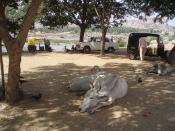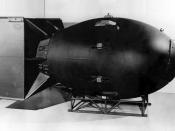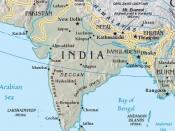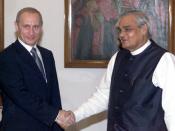203 Appendix D THE CHANGING POLITICAL-MILITARY ENVIRONMENT: SOUTH ASIA Ashley J. Tellis The security environment in South Asia has remained relatively un-settled since the Indian and Pakistani nuclear tests of May 1998. The Indian government's efforts to publicly emphasize the challenges China posed in the weeks leading up to those tests-after more than a decade of mostly sotto voce complaints-served to rupture the or-dinarily glacial process of normalizing Sino-Indian relations. This process always possessed a certain fragility in that the gradually de-creasing tensions along the Sino-Indian border did not automatically translate into increased trust between Beijing and New Delhi. Even as both sides sought to derive tactical advantages from the confi-dence- building measures they had negotiated since 1993-for ex-ample, the drawdown of forces along the utterly inhospitable LAC in the Himalayas-each ended up pursuing larger grand strategies that effectively undercut the other's interests. Beijing, for example, per-sisted in covertly assisting the nuclear and missile programs of India's local competitor, Pakistan, while New Delhi sought in re-sponse to develop an intermediate-range ballistic missile whose comparative utility lay primarily in targeting China.
The repeated identification of China as a threat to Indian interests by both Bharatiya Janata Party (BJP) leaders and other influential Indian elites in the first half of 1998 not only underscored the fragile nature of the Sino-Indian rapprochement but also ruptured the carefully maintained façade of improving relations between the two coun-204 The United States and Asia tries.1 When this public finger pointing ultimately gave way to India's resumption of nuclear testing on May 11, 1998 (an event ac-companied by the Indian prime minister's explicit claim that those tests were driven by the hostile actions of India's northern neighbor over the years), security competition in South Asia-which usually appears, at least in popular perceptions, as merely a bilateral affair between India and Pakistan-finally revealed itself as the "regional strategic triangle"2 it has always been.
This appendix analyzes Indian and Pakistani attitudes toward China in the context of the triangular security competition in South Asia.
Taking the 1998 nuclear tests as its point of departure, it assesses how China figures in the grand strategies of the two principal states in the Indian subcontinent and identifies the principal regional geopolitical contingencies for which the United States should pre-pare over the next decade. Finally, it briefly analyzes the kinds of opportunities the region offers to the USAF as it engages, even as it prepares to hedge against, a rising China.
NUCLEAR TESTING AND THE TRIANGULAR SECURITY COMPETITION IN SOUTH ASIA Impact of the Nuclear Tests on Sino-Indian Relations Although Pakistan was directly affected by the Indian nuclear tests, these tests engaged Chinese security interests as well. To begin with, India's decision to resume testing made manifest New Delhi's re-sentment toward Beijing for its almost two-decade-long assistance to Islamabad's nuclear and missile programs. India's official claim that its resumption of nuclear testing was precipitated at least in part by various Chinese actions (such as the transfer of nuclear weapon designs, short-range ballistic missiles, and assorted technologies in-tended to enable Islamabad to produce strategic systems indige-nously) was meant to signal the fact that India was capable of ______________ 1 These early 1998 events have been summarized in Manoj Joshi, "George in the China Shop," India Today, May 18, 1998, pp. 10-16.
2 For a good discussion, see Brahma Chellaney, "The Regional Strategic Triangle," in Brahma Chellaney (ed.), Securing India's Future in the New Millennium, New Delhi: Orient Longman, 1999, pp. 313-336.The Changing Political-Military Environment: South Asia 205 defending its own security interests-if necessary through unilateral solutions-and that improvement in some aspects of Sino-Indian bilateral relations could not be sustained if it came at the expense of undercutting the core objective of preserving India's safety, integrity, and primacy in South Asia.3 Further, the decision to test and the affirmation that India would de-velop a nuclear deterrent implied that New Delhi would at some point seek to target China with nuclear weapons. This effort at re-placing abject vulnerability with mutual vulnerability-no matter how asymmetrical it might be-suggested that Indian policymakers were unprepared to hang their hopes solely on the peacefulness of Chinese intentions, especially over the long term, given that Beijing's power is expected to grow even further and the relative differential in its strategic capabilities vis-Ã -vis New Delhi is likely to become even more manifest. India's decision to develop a nuclear deterrent thus suggests that India seeks at a minimum to possess the kinds of deter-rent capabilities that will immunize it against possible Chinese nu-clear blackmail in the event of a crisis.4 Finally, India's decision to resume nuclear testing has also been complemented by an effort to modernize the Indian military-an ef-fort that has encompassed upgrading India's conventional forces, including those elements tasked with defending the mountainous border areas facing both Pakistan and China. This modernization, which slowed down during the 1990s for financial reasons, is likely to gather momentum during the coming decade as Indian security managers increasingly recognize that, irrespective of what happens in the realm of diplomatic relations, maintaining robust conven-tional capabilities remains not only the best insurance against deter-rence breakdown but also a vital precondition for making good on India's public pledge never to use nuclear weapons first.5 ______________ 3 This theme is emphasized in J. Mohan Malik, "India Goes Nuclear: Rationale, Benefits, Costs and Implications," Contemporary Southeast Asia, Vol. 20, No. 2, August 1998, pp. 191-215.
4 The critical importance of deterring blackmail in Indian calculations is highlighted in Jasjit Singh, "Why Nuclear Weapons?" in Jasjit Singh (ed.), Nuclear India, New Delhi: Knowledge World, 1998, pp. 9-25.
5 For more on this calculus, see Tellis (2001).
206 The United States and Asia The Sino-Indian Balance India's recent decision to conduct nuclear tests, to develop a nuclear deterrent, and to accelerate the oft-postponed modernization of its conventional forces has often engendered the conclusion that New Delhi now views Beijing as a "clear and present danger" to its secu-rity.
In point of fact, this is not the case. To be sure, the Indian capi-tal would appear to be heavily populated by individuals, think tanks, and associations who vociferously assert the imminence of the Chi-nese threat. These claims are usually based either on Western reve-lations about Beijing's assistance to Islamabad's nuclear and missile programs and its murky activities in Burma or, alternatively, on dis-tant fears such as the prospect of a rapidly growing China "returning" to complete its agenda of "national reunification" at a time when it will have dramatically surpassed India in most of the relevant cate-gories of national power.6 These challenges, however-while ac-knowledged both by elected Indian officials and by the higher bureaucracy in New Delhi-have not produced the kinds of reactions Indian commentators have often expected because, put simply, In-dia's state managers have a much better grasp of the Sino-Indian power balance than many analysts give them credit for.
For more than a decade, Indian policymakers have in general pur-sued a subtle policy toward Beijing. Although the forceful statements of several Indian leaders in the months surrounding the nuclear tests were exceptions to this rule, more recent Indian initiatives vis-Ã -vis China-including the June 1999 visit of Indian Foreign Minister Jaswant Singh to Beijing-suggest that India's China policy has slowly swung back from the extreme of polemical criticism to a much more centrist effort at realistically managing the complexity and tensions inherent in the Sino-Indian relationship.7 The logic of this effort can best be appreciated in the context of un-derstanding the perceptions of senior Indian security managers with ______________ 6 These concerns are summarized in Amitabh Mattoo, "Complacency About Chinese Threat Called Frightening," India Abroad, April 5, 1996.
7 A good description of the complexity of Sino-Indian relations can be found in Surjit Mansingh, "Sino-Indian Relations in the Post-Cold War Era," Asian Survey, Vol. 34, No.
3, March 1994, pp. 285-300.






